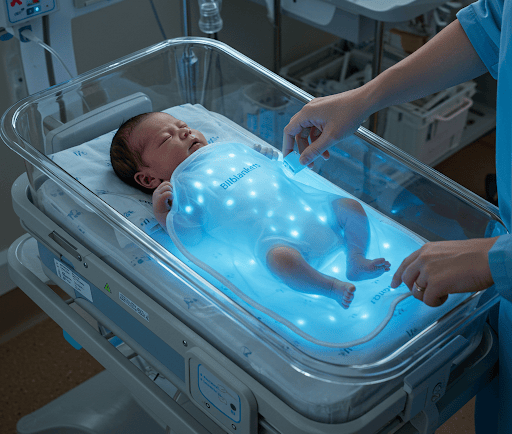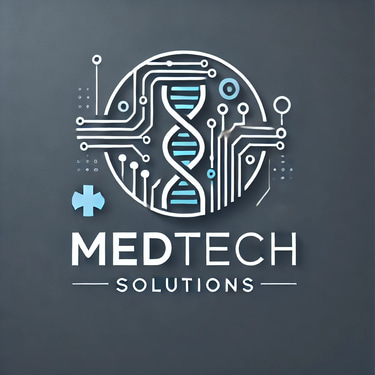Harnessing the Healing Power of Biliblankets: A Guide to Portable Phototherapy for Newborns
4/3/20254 min read


Understanding Biliblankets and Their Functionality
Biliblankets represent a significant advancement in the treatment of neonatal jaundice, a common condition characterized by elevated bilirubin levels in newborns. These innovative devices are designed to deliver phototherapy effectively, utilizing advanced fiber-optic technology. The core functionality of biliblankets revolves around their ability to emit a specific wavelength of light that interacts with the baby's skin to break down bilirubin, thereby facilitating its elimination from the body.
The design of biliblankets is notably user-friendly. They typically incorporate a soft, flexible material that wraps securely around the infant, providing coverage while ensuring comfort. The fiber-optic cables embedded within the blanket are responsible for distributing light evenly across the surface. This targeted approach allows the therapeutic light to work effectively on the affected areas of the skin, maximizing the treatment benefits while minimizing any potential disturbances to the newborn.
One of the key advantages of biliblankets is their portability. Unlike traditional phototherapy units, which are often bulky and require a dedicated setup, biliblankets can be used in various settings, including at home or in a hospital. This flexibility enables caregivers to provide continuous treatment without the limitations imposed by traditional equipment. Moreover, because biliblankets are designed to contour to the baby’s body, they facilitate more natural movement, allowing for ease of monitoring and care during the treatment process.
Ultimately, biliblankets exemplify a delicate balance between medical efficacy and practical application. Their innovative design not only supports the treatment of jaundice but also promotes a nurturing environment for the infant. As such, the use of biliblankets marks a progressive step in neonatal care, emphasizing the importance of comfort and convenience in treatment modalities.
Benefits of Using Biliblankets at Home
Biliblankets have emerged as a practical solution for phototherapy in the comfort of one's home, providing numerous benefits for both newborns and their families. One of the most significant advantages of utilizing biliblankets is the convenience they offer to parents. By allowing infants to undergo treatment at home, families can avoid the stress and disruption associated with prolonged hospital visits. This home-based approach not only fosters a more relaxed environment but also facilitates timely treatment, ensuring that jaundiced newborns receive the necessary care without the need for extended hospital stays.
Furthermore, biliblankets promote a comforting atmosphere that is essential for both mother and baby. The ability to care for their child in their familiar surroundings allows parents to maintain a close bond during treatment, which is beneficial for emotional well-being. Mothers can engage in everyday activities while ensuring their infant is receiving effective phototherapy, thus preserving a sense of normalcy during a potentially challenging time.
The design of biliblankets also plays a pivotal role in enhancing the treatment experience. These portable devices are lightweight, easy to use, and can be adjusted to suit the baby’s needs. This adaptability ensures that infants are not only receiving the necessary phototherapy but also are comfortable throughout the process. The soothing blue light emitted from the biliblankets is effective in treating neonatal jaundice, while their ability to wrap snugly around the baby helps to provide a familiar feeling of security.
In summary, using biliblankets at home streamlines the phototherapy process, offering convenience and comfort for both the infant and their family, while promoting essential bonding time during treatment. This innovative approach has transformed how jaundice is managed in newborns, enhancing their healing journey in a nurturing environment.
Safety and Effectiveness of Biliblankets
Biliblankets have emerged as a significant advancement in the treatment of hyperbilirubinemia in newborns, providing a safe and effective means of phototherapy. Several studies have affirmed their efficacy, one notable example being research by Ebbesen et al. (2004), which detailed positive outcomes associated with their use in clinical environments. The use of these portable devices has demonstrated that they can reduce bilirubin levels efficiently, often without necessitating hospitalization, which benefits both the infant and the family.
In terms of safety, biliblankets are designed with specific protocols to mitigate any potential risks associated with phototherapy. They emit blue light at wavelengths that are optimal for facilitating the breakdown of bilirubin in the skin. Importantly, the blankets are lightweight and flexible, allowing for ease of use while ensuring that infants can maintain comfort. The United States Food and Drug Administration (FDA) has recognized biliblankets as safe when used according to the manufacturer's guidelines, which emphasizes the importance of proper adherence to usage instructions.
Despite their overall safety, certain precautions must be implemented to safeguard the well-being of the newborn during treatment. Parents are advised to monitor the infant closely, ensuring that the device is functioning properly and that the small newborn is positioned correctly. Additionally, it is essential to protect the baby's eyes, as direct exposure to the blue light can damage vision. Most biliblankets come with eye shields or masks to mitigate this risk. By following the provided guidelines and consulting with healthcare providers, parents can effectively harness the healing power of biliblankets in a secure manner, ensuring their infant receives the necessary care to address elevated bilirubin levels.
Tips for Using a Biliblanket at Home
Using a biliblanket at home can be a straightforward process that aids in the treatment of jaundice in newborns. Properly positioning the biliblanket is essential for ensuring effective phototherapy. Place the blanket directly under the baby with the light source facing up, making sure that the entire back area gets ample exposure to the light. It is crucial to ensure that the baby does not experience any discomfort from the heat emitted by the blanket; regular checks can be helpful to adjust the blanket's position if necessary.
Monitoring the effectiveness of the biliblanket therapy is vital. Parents should keep a record of their newborn’s bilirubin levels as advised by the healthcare provider. Additionally, observe the baby closely during treatments for any signs of discomfort or distress, such as fussiness or changes in skin color. These observations can provide essential information for healthcare professionals regarding the effectiveness of the treatment.
Creating a soothing environment around the biliblanket is equally important. Dimming the lights and reducing noise can help in promoting a calming atmosphere that may soothe the baby during phototherapy. Consider using soft, gentle sounds, such as lullabies or white noise, to help the newborn relax. Wrapping the baby in a lightweight cloth or blanket can also provide comfort, but ensure that this does not obstruct the light's exposure.
Furthermore, it’s important to follow the recommendations and guidelines provided by the pediatrician regarding the duration and frequency of use. Parents should also be prepared to take short breaks to hold and cuddle their newborn, as skin-to-skin contact can be reassuring for the baby and beneficial for bonding. By following these tips, parents can effectively utilize a biliblanket at home while ensuring their newborn’s comfort and well-being during treatment sessions.
